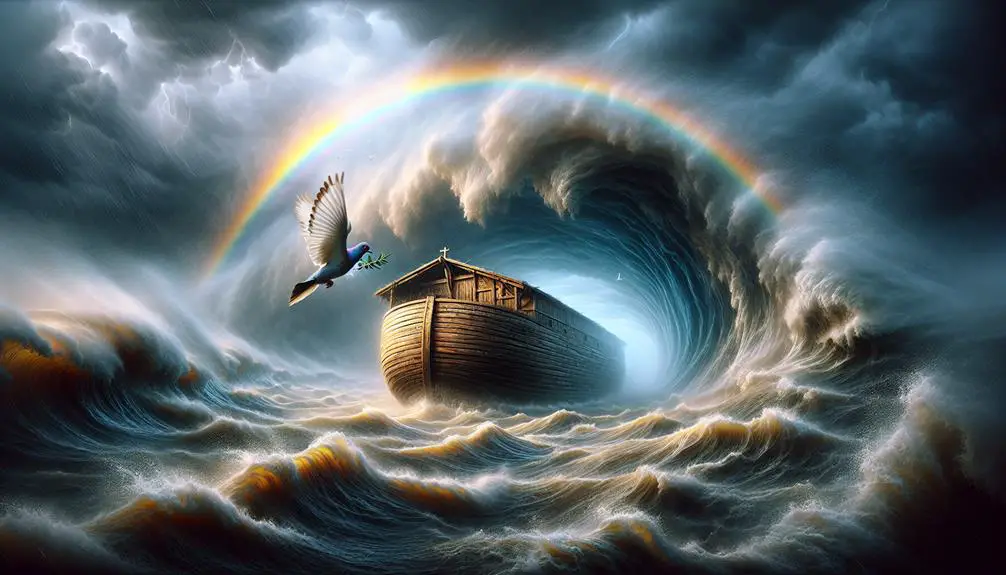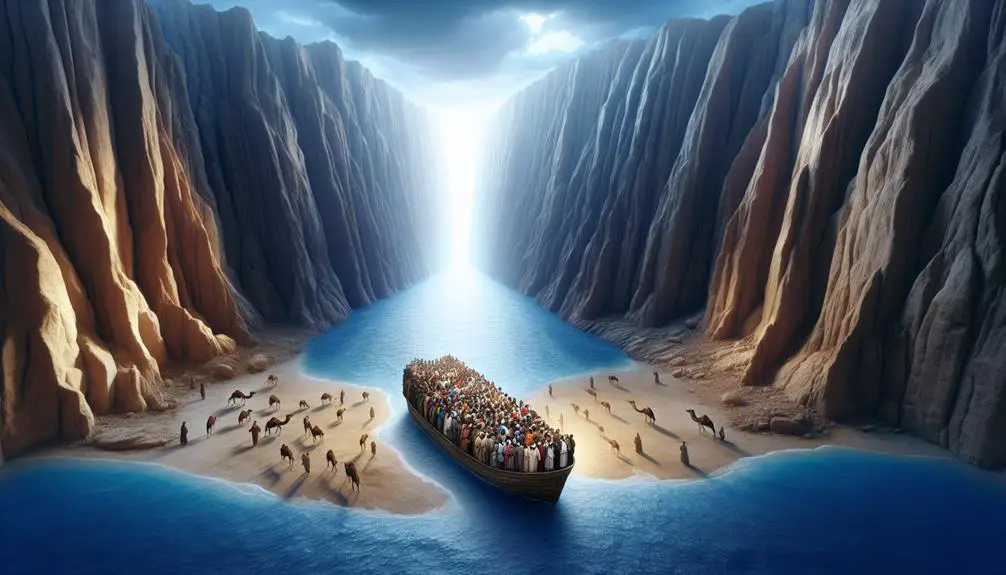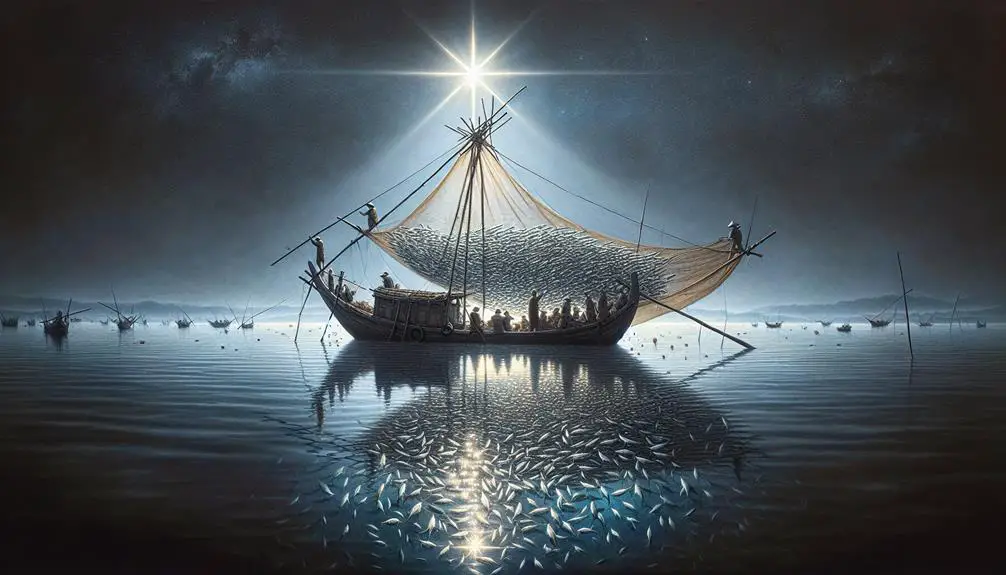Discover how boats in the Bible navigate more than just water, revealing lessons on faith and life's storms.

Boat Symbolism in the Bible
As you navigate through the tumultuous seas of life, it's fascinating to see how boats embody profound symbolism in the Bible. From Noah's Ark representing divine salvation to Jesus calming the storm, these narratives aren't just stories; they're lessons woven into the fabric of faith.
Whether it's Peter walking on water or the disciples fishing for followers, each account holds deeper meanings about trust, fear, and the journey of spirituality. As we cast our nets further into this discussion, you'll discover layers of interpretation that may have previously sailed past you, offering fresh insights into these ancient texts.
Key Takeaways
- Boats in the Bible symbolize divine salvation and deliverance, as seen in Noah's Ark and the crossing of the Red Sea.
- They represent faith amidst challenges, illustrated by stories like Jesus calming the storm and Peter walking on water.
- Biblical boat narratives often highlight the triumph of divine will, showcasing God's power over natural and human obstacles.
- Water and boats serve as powerful metaphors for transformation, redemption, and the journey towards spiritual enlightenment.
Noah's Ark: Divine Salvation

In the biblical narrative, Noah's Ark symbolizes God's provision of salvation, offering a profound lesson on divine mercy and human obedience. The Genesis account details the Ark's construction and the global flood, serving as a pivotal example of faith in action. You're drawn into a story where meticulous obedience to divine instructions for the Ark's construction reflects a deeper trust in God amidst impending judgment.
The narrative underscores the Ark as more than a mere vessel of survival; it's a testament to God's covenant with humanity. By adhering to God's precise specifications, Noah not only secures his family's safety but also preserves the future of all living creatures. The global flood, often debated and dissected, signifies a reset of creation, washing away the corruption that had overwhelmed the earth. This cataclysmic event, while destructive, ushers in a new beginning, grounded in divine mercy and a renewed relationship between God and His creation.
Analyzing the Ark's construction and the global flood, you're invited to contemplate the weight of obedience and faith. The Ark, built in a time of widespread skepticism, stands as a physical representation of faith in the unseen and unproven. It's a scholarly reminder that divine salvation often requires unwavering faith in God's promises, even when they seem impossible or illogical from a human perspective.
This account challenges you to see beyond the historical and architectural aspects of the Ark, encouraging a deeper reflection on its symbolic significance. It's a call to recognize God's provision of salvation, echoing through time as a reminder of His enduring mercy and the importance of obedience in the face of divine directives.
Jesus Calms the Storm

Shifting our focus to the New Testament, we find another profound maritime narrative where Jesus calms the storm, showcasing His dominion over nature and emphasizing the theme of faith amidst fear. This story, rich in storm symbolism, serves as a timeless metaphor for life's tumultuous situations where fear seems to overpower faith.
In this narrative, Jesus invites you to witness His peace in the midst of chaos. As He sleeps soundly in the boat, His disciples are consumed by fear, a powerful reminder of human vulnerability. The storm's suddenness and ferocity symbolize the unpredictable challenges you may face, where solutions seem as distant as the receding shore.
When Jesus awakens and rebukes the wind and the waves, He not only demonstrates His control over the physical realm but also issues a call to overcome fear with faith. This act transcends mere weather manipulation; it's a profound declaration of His divine authority and a testament to the power of faith to bring tranquility into your life's storms.
- *The stilling of the storm evokes a sense of awe and humility, reminding you of the Divine's presence in every circumstance.*
- *Jesus' calm demeanor amidst chaos encourages you to find peace in your faith, regardless of the storm's severity.*
- *The disciples' fear and subsequent amazement mirror your own journey from fear to faith, highlighting the importance of trusting in something greater than yourself.*
Analyzing this narrative, you're invited to reflect on the deeper implications of storm symbolism and the enduring message of fear overcoming through faith.
Peter Walks on Water

Continuing our exploration of biblical maritime narratives, we encounter the moment when Peter walks on water, a profound demonstration of faith amidst doubt. This event, rich in miraculous faith and water symbolism, stands as a testament to the power of belief over the physical laws of nature. Here, the sea isn't just a body of water but a representation of the chaotic and uncertain aspects of life. Peter's decision to step out of the boat, at Jesus' call, symbolizes an act of trust in the divine, even when it seems irrational.
As you delve deeper, you'll find that this story isn't just about walking on water but about the struggle between faith and doubt. When Peter keeps his eyes on Jesus, he walks on the miraculous. Yet, the moment he shifts his focus to the stormy sea, fear takes over, and he begins to sink. This pivotal moment highlights the fluctuating nature of human faith but also Jesus' immediate response to rescue Peter, emphasizing divine grace and mercy.
This narrative urges you to reflect on your own life's storms and the invitation to trust in something greater than yourself. It challenges you to step out in faith, even when you're surrounded by uncertainty. The water, in this context, becomes a symbol of the trials and tribulations you face.
Crossing the Red Sea

As you explore the narrative of Crossing the Red Sea, you'll encounter a profound demonstration of miraculous sea parting, showcasing God's power and provision.
This event stands as a testament to faith amidst adversity, where the Israelites' trust in God leads them through seemingly insurmountable challenges.
Furthermore, the defeat of Pharaoh's army not only signifies divine justice but also marks a pivotal moment in the journey of God's chosen people, reinforcing themes of deliverance and protection.
Miraculous Sea Parting
Parting the Red Sea stands as a pivotal moment in biblical history, symbolizing God's power and deliverance for the Israelites from Egyptian bondage. This event is a cornerstone of ocean theology and maritime faith, illustrating the profound ways in which water bodies are woven into the narrative of divine intervention and human experience. The miraculous sea parting transcends mere historical account; it serves as a testament to the unwavering faith of those who were led to freedom.
It evokes a sense of awe at the magnitude of God's intervention.
It inspires faith in the seemingly impossible.
It reassures of divine presence in times of peril.
Analyzing this event through a scholarly, faith-based lens allows you to appreciate the depth of its symbolic significance, reaffirming the power of belief and the eternal message of hope and deliverance.
Faith Amidst Adversity
Crossing the Red Sea embodies a profound demonstration of faith amidst adversity, showcasing how trust in divine guidance leads to miraculous deliverance. This narrative isn't merely a tale of escape but a testament to ocean trust and stormy faith.
You're invited to consider the depths of your own beliefs when faced with insurmountable obstacles. Just as the sea parted, revealing a path of salvation, your steadfast faith in tumultuous times can forge unexpected avenues of rescue.
The Israelites' journey across the Red Sea serves as a powerful metaphor for navigating life's challenges. It teaches that when you're hemmed in by life's storms, your faith—your ocean trust—can illuminate paths through the impossible, guided by a force greater than the stormy seas you face.
Pharaoh's Army Defeat
The defeat of Pharaoh's army in the Red Sea marks a pivotal moment in biblical history, symbolizing God's protective power over His faithful amidst seemingly insurmountable adversity. This event intertwines military strategy with divine intervention, where water symbolism represents both physical and spiritual salvation.
Analyzing this moment, you'll find:
- The strategic use of natural elements, showcasing an unparalleled military strategy that defies human logic.
- Water symbolism as a barrier and protector, emphasizing the separation between enslavement and freedom.
- An emotional depth that stirs faith, highlighting the triumph of the divine will over earthly powers.
In this narrative, the Red Sea becomes a stage for a profound demonstration of faith, where the waters serve as both a literal and metaphorical means of deliverance from tyranny.
Jonah's Great Fish

In exploring the symbolism of boats in biblical narratives, one can't overlook Jonah's encounter with the great fish as a pivotal moment of divine intervention and personal transformation. This episode, far more than a mere adventurous tale, stands as a profound repentance symbol within the scriptural context. You're invited to delve into the depths of its meaning, beyond the surface of the ocean's waves.
Jonah's initial refusal to heed God's command to deliver Nineveh's warning underscores a universal human tendency to flee from divine directives that seem daunting or disagreeable. His subsequent journey by sea, culminating in his swallowing by a great fish, serves as a dramatic illustration of divine chastisement paired with mercy. The fish, rather than being an agent of punishment, embodies God's grace, offering Jonah a period of reflection and repentance in the belly of a beast.
This extraordinary sojourn within the fish is symbolic of the transformative power of repentance. It's a testament to the fact that one can't outrun divine will but can find redemption through sincere contrition and obedience. Jonah's eventual release and renewed commitment to fulfill God's command signify not only his personal transformation but also prefigure the possibility of Nineveh's redemption through repentance.
Thus, Jonah's great fish emerges not merely as a miraculous element of a historical narrative but as a rich symbol of the journey toward spiritual awakening and fulfillment of divine purpose. It reminds you that even in the depths of despair and disobedience, there's always an opportunity for redemption and alignment with God's will.
Fishing for Followers

You'll find that the Bible employs the metaphor of fishing to depict the disciples' journey from simple fishermen to gatherers of believers, illustrating a profound transformation. This symbolic net casting represents not just the act of conversion but the disciples' commitment to spread the teachings of Jesus far and wide.
Viewing their conversion to fishers of men, one appreciates the depth of their faith and dedication to their mission.
Disciples' First Call
Drawing upon the Gospel narratives, one finds a compelling account of Jesus calling his first disciples, employing the metaphor of fishing to symbolize the gathering of followers. This pivotal moment unfolds beside Lake Gennesaret, where future disciples are first encountered. Among them are Zebedee's sons, who'd leave their nets behind to follow a path of spiritual awakening and service. This scene isn't just a call but a profound transformation.
- Hope: The promise of becoming 'fishers of men' instills a new purpose.
- Faith: Leaving their livelihoods, they exhibit unyielding trust in Jesus.
- Transformation: From fishermen to disciples, their identities are forever changed.
Through this narrative, one discerns the deep layers of meaning in their first call, emphasizing a journey from the known to the spiritual unknown.
Symbolic Net Casting
Exploring further, we see that the act of casting nets not only illustrates the method of fishing but also deeply symbolizes the endeavor of gathering followers in a faith-based context. This action, rich in ocean metaphors, mirrors the vast, unpredictable sea of human souls. Harvest imagery further enriches this symbolism, portraying the gathering of believers as a bountiful harvest.
Aspect |
Symbolism |
|---|---|
Net Casting |
Gathering of followers |
Ocean Metaphors |
Vastness and diversity of believers |
Harvest Imagery |
Abundance and nourishment of faith |
Fish |
Individual souls |
These elements together paint a vivid picture of spiritual leadership and discipleship, emphasizing the importance of outreach and the nurturing of faith communities.
Conversion to Fisher
Delving into the metaphor of fishing, the Bible often transforms believers into fishers of men, tasking them with the mission to spread faith and gather followers. This vocational symbolism is rich in aquatic metaphors, painting a vivid picture of spiritual conversion and commitment. You're called not just to navigate the waters of faith but to cast nets wide, embodying the role of a spiritual angler in the vast ocean of humanity.
- *The call to fish for followers evokes a sense of purpose and urgency.*
- *Aquatic metaphors deepen the spiritual connection to life's ebb and flow.*
- *Vocational symbolism inspires a proactive stance in one's faith journey.*
This analytical view underscores a key biblical theme: faith isn't passive; it's an active, ongoing mission to engage and inspire, drawing others into the fold.
Frequently Asked Questions
How Does Boat Symbolism in the Bible Relate to Ancient Maritime Cultures and Their Beliefs?
In ancient maritime cultures, boats were central not just for maritime trade but also reflected deep-seated beliefs. You'll find that their reliance on boats for fishing techniques wasn't just practical; it symbolized a profound connection with the divine, providing sustenance and safety.
This reverence is echoed in biblical texts, where boats often represent faith's journey across life's tumultuous seas, showcasing a blend of historical practice and spiritual symbolism.
Are There Any Specific Types of Boats Mentioned in the Bible, and What Do They Symbolize in a Broader Historical or Cultural Context?
Diving into the text, you'll find various boats, each carrying a deeper meaning. From simple fishing vessels to sophisticated examples of naval construction, these references aren't just historical footnotes.
They reflect ancient fishing techniques, showcasing a blend of practical skills and spiritual symbolism. By analyzing these boats, you're not just exploring ancient craftsmanship; you're uncovering layers of faith and culture, where every plank and sail speaks volumes about the society that built them.
How Is the Symbolism of Boats in the Bible Used to Convey Themes of Journey and Transformation in Personal Faith?
In exploring themes of journey and transformation in personal faith, you'll find boats serve as powerful metaphors. They embody navigational skill, reflecting the guidance needed to traverse life's uncertainties.
Moreover, storm endurance symbolized by boats highlights the resilience required in faith's journey. Through these vessels, you're invited to consider how faith navigates and withstands challenges, ultimately steering towards transformation and deeper understanding.
This analysis illuminates the spiritual voyage's complexity and beauty.
Did Early Christian Communities Use Boat Symbolism in Their Art and Architecture, and if So, How Did It Reflect Their Spiritual Beliefs?
Yes, early Christian communities indeed incorporated boat symbolism into their art and architecture, reflecting their spiritual beliefs. By using maritime laws and construction techniques as metaphors, they conveyed messages of salvation and guidance.
This imagery drew parallels between navigating the treacherous seas and the Christian journey of faith, emphasizing trust in divine guidance.
Their faith-based, analytical approach showcased a scholarly understanding of both spiritual and maritime realms, underscoring the journey towards salvation.
How Do Modern Interpretations of Boat Symbolism in the Bible Differ From Traditional Understandings, Especially in Light of Contemporary Environmental Challenges Such as Climate Change and Rising Sea Levels?
You're exploring how today's environmental challenges, like climate change and rising sea levels, reshape understanding of biblical symbols. Modern spirituality often reinterprets these symbols through a lens of environmental stewardship, diverging from traditional views.
This shift reflects a deeper engagement with the Bible's teachings on caring for creation. It's a fascinating evolution, showing how faith communities adapt their interpretations to address the pressing issues of their time.
Conclusion
In exploring boat symbolism within the Bible, you've journeyed through narratives of divine salvation, miraculous interventions, and profound faith. From Noah's Ark to Jesus calming the storm, each story intricately weaves the motif of deliverance and trust in the divine.
Similarly, Peter's walk on water, the crossing of the Red Sea, Jonah's great fish, and the call to fish for followers encapsulate themes of obedience, redemption, and divine purpose. Through these narratives, you're reminded that in life's tumultuous seas, faith anchors the soul, guiding believers to divine harbors.



Sign up